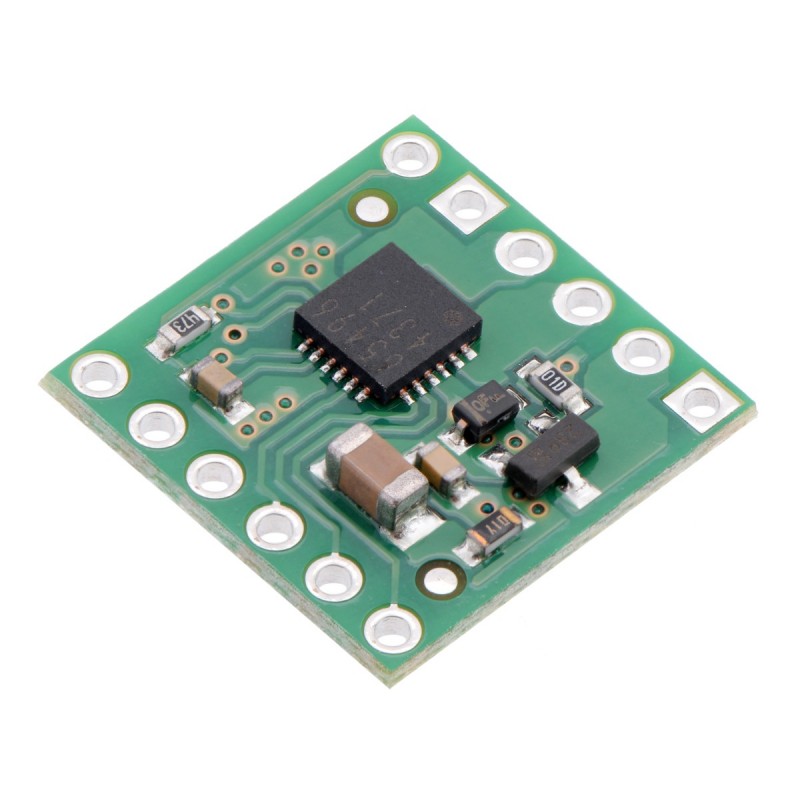







57,79 zł Netto
Moduł pozwala na zmianę prędkości obrotowej silnika poprzez regulację PWM o częstotliowści do 500 kHz. Posiada wbudowane zabezpieczenie przed podaniem odwrotnej polaryzacji zasilania oraz zabezpieczenie termiczne. Pololu 2960
Opis
Kompaktowa płytka pośrednia (breakout board) oparta na sterowniku silników ROHM BD65496MUV, przeznaczona do dwukierunkowego sterowania jednym szczotkowym silnikiem DC. Układ pracuje w szerokim zakresie napięć 2 V – 16 V i umożliwia dostarczenie do 1,2 A prądu ciągłego (do 5 A w impulsie przez kilka milisekund).
Dzięki bardzo małym rozmiarom oryginalnego układu SMD, jego samodzielne użycie bywa trudne – wersja Pololu rozwiązuje ten problem, udostępniając wyprowadzenia w rastrze 2,54 mm, idealne do płytek stykowych i prototypowych. Dodatkowo płytka zawiera zabezpieczenie przed odwrotną polaryzacją zasilania.
Silnik, przewody oraz mikrokontroler nie są dołączone
Cechy
Producent BTC Korporacja sp. z o. o. Lwowska 5 05-120 Legionowo Polska sprzedaz@kamami.pl 22 767 36 20
Osoba odpowiedzialna BTC Korporacja sp. z o. o. Lwowska 5 05-120 Legionowo Polska sprzedaz@kamami.pl 22 767 36 20
Moduł sterownika RC typu ESC przeznaczony do silników szczotkowych o napięciu zasilania od 3,5 do 6 V i poborze prądu 1 A
Regulator prędkości ESC ODrive3.6 przeznaczony jest do zasilania dwóch trójfazowych silników bezszczotkowych w różnych aplikacjach, takich jak roboty jeżdżące, roboty kroczące czy gimbale. Obsługuje zakres napięcia wejściowego od 12 V do 56 V oraz maksymalny prąd do 60 A. Makerbase ODrive3.6
Brak towaru
Jednokanałowy sterownik silników DC z interfejsem UART TTL. Jest zasilany napięciem od 1,8 V do 22 V i może dostarczyć prąd o natężeniu do 1,8 A. Płytka ze złączami do montażu. Pololu 5077
Pololu Jrk 21v3 USB Motor Controller with Feedback
Brak towaru
Moduł dwukanałowego sterownika silników DC oparty o popularny mostek H L298, zasilany napięciem 6-35 V, maksymalny pobór prądu na jeden kanał 2A, radiator do chłodzenia układu. SparkFun ROB-09670
Brak towaru
Pololu G2 24v12 High Power to miniaturowy sterownik silnika DC. Zasilanie sterownika: 6,5...30V. Wydajność prądowa modułu: 12A. Moduł posiada zabezpieczenie przed napięciem wstecznym i przepięciami. Pololu 1365
Brak towaru
Jednokanałowy sterownik silników DC z interfejsem I2C. Jest zasilany napięciem od 4,5 V do 48 V i może dostarczyć prąd o natężeniu do 2,2 A. Płytka z przylutowanymi złączami. Pololu 5060
Brak towaru
Dual MAX14870 Motor Driver to podwójny sterownik silników DC kompatybilny ze standardem Arduino pozwalający na wysterowanie dwóch silników DC napięciem 4,5-36V prądem ciągłym 1,7A. Pololu 2519
Kompaktowy sterownik silnika krokowego z układem TMC2208 o napięciu pracy od 4 do 35 V. Oferuje płynną, cichą pracę, wysoką wydajność, różnorodne tryby pracy oraz łatwą konfigurację. Jest sterowany przez interfejs STEP/DIR i stanowi idealne rozwiązanie dla drukarek 3D oraz podobnych zastosowań
Moduł sterownika silnika krokowego DRV8825 dla Arduino. Pozwala na sterowanie dwoma napędami, wyposażony w złącze XBee. DFRobot DRI0023
Sterownik silników DC, który pozwala na kontrolowanie ruchu dwóch napędów za pomocą interfejsu I2C. Płytka z przylutowanymi złączami. Pololu 5051
Brak towaru
X-NUCLEO-IHM16M1 to płytka rozszerzeń ze sterownikiem trójfazowego bezszczotkowego silnika zasilanym napięciem w zakresie 7-45 V o maksymalnym prądzie wyjściowym 1,5 A w każdym z kanałów. Kompatybilny z STM32 Nucleo. X-NUCLEO-IHM16M1
Brak towaru
Moduł ze sterownikiem silnika krokowego TMC2208. Umożliwia sterowanie z napięciem zasilania z zakresu od 5,5 do 35 V oraz prądem do 1,2 A
Moduł rozszerzeń przeznaczony do współpracy z płytką edukacyjną micro:bit. Może sterować 3 serwomechanizmami i 2 silnikami prądu stałego. Waveshare Motor Driver for micro:bit
Moduł z dwoma sterownikami silników DC DRV8830. Płytka została wyposażona w złącze Grove i komunikuje się przez interfejs I2C. Seeed Studio 105020010
Kompaktowy sterownik, który umożliwia precyzyjne sterowanie bipolarnymi silnikami krokowymi. Oferuje dużą precyzję ruchu dzięki możliwości sterowania silnikiem krokowym z rozdzielczością do 1/128 kroku oraz dwa interfejsy sterujące - sterowanie krokowe typu clock-in oraz komendy szeregowe. SparkFun ROB-25167

Moduł pozwala na zmianę prędkości obrotowej silnika poprzez regulację PWM o częstotliowści do 500 kHz. Posiada wbudowane zabezpieczenie przed podaniem odwrotnej polaryzacji zasilania oraz zabezpieczenie termiczne. Pololu 2960
